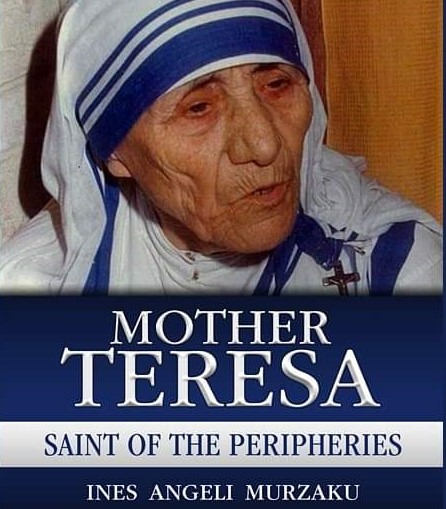Merita B. McCormack: A book Review- Mother Teresa – Saint of the Peripheries

Dr. Ines A. Murzaku’s newest book on Mother Teresa is a very good and an enjoyable read. Though for us Albanians many facts of the Saint’s life are known, there are more to learn.
But what is more important, it is the essence of the book and the deep look into the new title given to this Saint by the author as ” The Saint of the Peripheries”. A very fitting one!
We all are familiar with the saint’s deeds, in general, and we are familiar with her dark night and her never giving up, for the Love of God. She knew Jesus’ thirst, she knew his wounds and she tended to them.
This is very impressive and unmatchable by us, mere mortals here on Earth.
But then the reader comes across not another biography of the most famous and beloved Albanian saint, but a fine scientific study, where the Albanian DNA of Mother Teresa is looked into detail from a very different angle and in a new light, like never seen before. That light on the Albanian blood and the formation as an Albanian young woman, doesn’t mean that other nations do not have their favorite grandma being just like a “mother Teresa” of their own, but the very fact of an interfaith culture of the small country of origin, where everyone cares for the other in a special, unique way, Mother Teresa learned as a little child to serve everyone and love everyone for the love of God. To her, everyone was the same in dignity and value, she saw with the eyes of Christ, and she witnessed what her parents did.
And she reached out to everyone first at home to prepare for the future noble, saintly mission.
The book is a rich study and it takes time to read and think about it. Each chapter is a study on its own and the way it is written includes storytelling and analysis, combining them so well, that the reader doesn’t want to stop reading.
The theology of the peripheries is examined in the prologue. And it gives the reader a general idea of how fitting this definition -Saint of Peripheries- is for Mother Teresa’s spirituality and deeds.
The book has three major parts. Dr. Murzaku’s steady study and presentation of Mother Teresa’s journey begins with her personal peripheries, how was she formed, who was she before the world met her as Mother Teresa, what did her trajectory looks like, what was the political life of her time, language, faith tradition of her neighbors and more. In the first part she includes the beginning of her call, describes Our Lady of Letnica family devotion to the School of Periphery , furthers the mission in India and touches on Spiritual Darkness . All of those aspects are looked at in depth and explained.
I recall the unease I have had with even some Albanian authors who question the motives of the saint to go to India. But when you read this book, it is clear as the light of the day, that God called Mother Teresa to the peripheries and she obliged. She, imitating our lady, gave her fiat too. Reading about the Spiritual Darkness of the Saint, one can’t help but think. It is a fitting aspect of the peripheries. Her white martyrdom was real, God felt distant for her, and she accepted it as a gift.
The Second Part of The book deals with the Mystical peripheries.
It is such an inspiring part of the book. I recall Fr. Michael Gaitly’s book on 33 Days of Consecration to Mary where he examines a part of Mother Teresa’s Marian spirituality and feels really good that she is studied along with Sts. John Paul the Second and Maximilian Kolbe. But Dr. Murzaku’s study goes so deep and her analogies are so beautiful that one can not distinguish who is Mother Teresa’s mystical better match for certain aspects. Is it St. Francis, Saint Benedict, Saint John Paul the Second, St Padre Pio? All very well explained.
And then the last part explains the contemporary peripheries and of course, it goes to the heart of the matter. Because it is Pope Francis who resurrected the theology of the periphery and Mother Teresa’s life and work is just about that. It is like a little discovery found in plain sight but somehow not seen or talked as much about it. But now we have a well written and very well received book and I am so glad that a sister in blood (Albanian) wrote it. I highly recommend it to everyone.
It is published by the Paulist Press and here is a link to the Publisher.
https://www.paulistpress.com/Products/8-750-1/mother-teresa.aspx